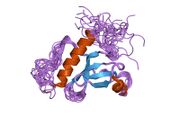Biology:WHSC1L1
From HandWiki
Short description: Protein-coding gene in the species Homo sapiens
 Generic protein structure example |
Histone-lysine N-methyltransferase NSD3 is an enzyme that in humans is encoded by the WHSC1L1 gene.[1][2]
This gene is related to the Wolf–Hirschhorn syndrome candidate-1 gene and encodes a protein with PWWP (proline-tryptophan-tryptophan-proline) domains. The function of the protein has not been determined. Two alternatively spliced variants have been described.[2]
The WHSC1L1 gene is amplified in several cancers, including lung cancer and head and neck cancer, and may play a role in carcinogenesis.[3][4]
References
- ↑ "The PWWP domain: a potential protein-protein interaction domain in nuclear proteins influencing differentiation?". FEBS Lett 473 (1): 1–5. Jun 2000. doi:10.1016/S0014-5793(00)01449-6. PMID 10802047.
- ↑ 2.0 2.1 "Entrez Gene: WHSC1L1 Wolf-Hirschhorn syndrome candidate 1-like 1". https://www.ncbi.nlm.nih.gov/sites/entrez?Db=gene&Cmd=ShowDetailView&TermToSearch=54904.
- ↑ Kang, D; Cho, HS; Toyokawa, G; Kogure, M; Yamane, Y; Iwai, Y; Hayami, S; Tsunoda, T et al. (Feb 2013). "The histone methyltransferase Wolf-Hirschhorn syndrome candidate 1-like 1 (WHSC1L1) is involved in human carcinogenesis.". Genes, Chromosomes & Cancer 52 (2): 126–39. doi:10.1002/gcc.22012. PMID 23011637.
- ↑ Chen, Y; McGee, J; Chen, X; Doman, TN; Gong, X; Zhang, Y; Hamm, N; Ma, X et al. (2014). "Identification of Druggable Cancer Driver Genes Amplified across TCGA Datasets.". PLOS ONE 9 (5): e98293. doi:10.1371/journal.pone.0098293. PMID 24874471. Bibcode: 2014PLoSO...998293C.
Further reading
- "NSD3, a new SET domain-containing gene, maps to 8p12 and is amplified in human breast cancer cell lines.". Genomics 74 (1): 79–88. 2001. doi:10.1006/geno.2001.6524. PMID 11374904.
- "WHSC1L1, on human chromosome 8p11.2, closely resembles WHSC1 and maps to a duplicated region shared with 4p16.3.". Genomics 76 (1–3): 5–8. 2001. doi:10.1006/geno.2001.6581. PMID 11549311.
- "NUP98 is fused to the NSD3 gene in acute myeloid leukemia associated with t(8;11)(p11.2;p15)". Blood 99 (10): 3857–60. 2002. doi:10.1182/blood.V99.10.3857. PMID 11986249.
- "Generation and initial analysis of more than 15,000 full-length human and mouse cDNA sequences". Proc. Natl. Acad. Sci. U.S.A. 99 (26): 16899–903. 2003. doi:10.1073/pnas.242603899. PMID 12477932. Bibcode: 2002PNAS...9916899M.
- "Complete sequencing and characterization of 21,243 full-length human cDNAs". Nat. Genet. 36 (1): 40–5. 2004. doi:10.1038/ng1285. PMID 14702039.
- "The status, quality, and expansion of the NIH full-length cDNA project: the Mammalian Gene Collection (MGC)". Genome Res. 14 (10B): 2121–7. 2004. doi:10.1101/gr.2596504. PMID 15489334.
- "High-resolution genomic profiles of human lung cancer". Proc. Natl. Acad. Sci. U.S.A. 102 (27): 9625–30. 2005. doi:10.1073/pnas.0504126102. PMID 15983384. Bibcode: 2005PNAS..102.9625T.
- "Characterization of a novel WHSC1-associated SET domain protein with H3K4 and H3K27 methyltransferase activity". Biochem. Biophys. Res. Commun. 345 (1): 318–23. 2006. doi:10.1016/j.bbrc.2006.04.095. PMID 16682010.


